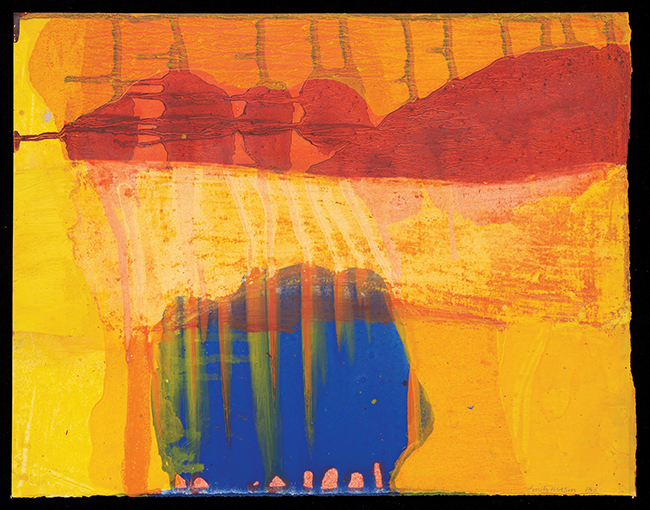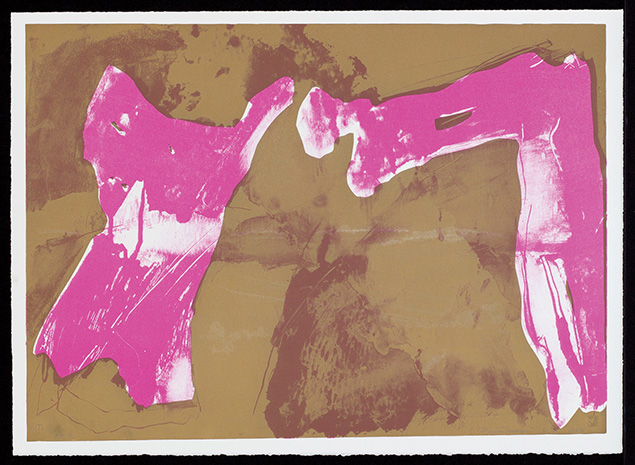She Sweeps with Many-Colored Brooms: Paintings and Prints by Emily Mason
Bruce Museum • Greenwich, CT • brucemuseum.org • Through March 21, 2021
She Sweeps with Many-Colored Brooms: Paintings and Prints by Emily Mason, a generous exhibition of over four dozen artworks at the Bruce Museum in Greenwich, CT, takes its title from a poem by Emily Dickinson, Mason’s namesake. The insular Dickinson avoided the limelight, wrapping poems in ribbons and hiding them in drawers. Once posterity caught up, Dickinson ascended to lyricism’s pantheon.
Expertly curated by a team, including Robert Wolterstorff, Bruce executive director and CEO, Kenneth E. Silver, adjunct curator of art and professor of art history, New York University, and resident fellow Hal Miller, the paintings and prints on view make a case for Mason as a major artist, holding her own within her generation of abstract painters as well as her tightly knit circle: Alice Trumbull Mason, her mother, whose storied life included a Parisian studio in the building where Joan Miró also painted, and her husband, landscape painter Wolf Kahn.
Mason and Kahn both favored a palette of analogous colors—ruddy purples, lemony oranges, willowy greens. Toward the end of Kahn’s career, he too embraced atmosphere over form, applying sensuous tonalities that suggest Mason’s own personal language.

Ask the East (oil on paper, 1968), fuses rigor and letting go, control and intuition. Sweeping, gestural layers of scarlet orange shelter a cascade of canary-colored drips, yellows tumbling into solid blue before pulsing into stalks of green. Using paper rather than canvas allowed for quick drying, as well as the drips more characteristic of watercolor. “Mason achieved monumental painterly effects in miniature,” writes Silver in his catalog essay. Working in a smaller scale, Mason could more easily tip the support, applying color from all sides, each layer responding to a previous layer in a dance of chance and control.
In a touch of poetic irony, Mason died at age 87, on December 10, 2019, the anniversary of Emily Dickinson’s birth. Surrendering to the swirling forms of color embedded in Mason’s art, the eye delights in purples, ambers, and emeralds, colors named in Dickinson’s poem. Mason’s own “broom(s)” are both conventional and improvised (brushes, rags, sponges, fingers). With these simple tools, she continually experimented with pigments onto surfaces—canvas, paper, acrylic plates—for more than six decades and at different times and places. These include Italy, where she began working with oil paint on paper, a winter studio in New York, and a farm in Vermont—a summer refuge and source of inspiration.
And like Dickinson, whose art registered her internal temperature, Mason often eschewed the limelight, remaining cryptic during interviews and letting the timeless, ethereal quality of the work speak for itself. She chided printmaker and collaborator David Ebony, who supported Mason through the process of putting together two volumes of her work, for “trying to get her to toot her own horn.”

The Bruce had planned to showcase Mason before her death; the timing of the current exhibition, when the world needs Mason’s colors, makes this show all the more welcome. Its focus spans two aspects of Mason’s career: her oil and pastel paintings on paper, and later-career involvement with what she called printed painting. Working with master printers, Mason began to incorporate colored inks with Carborundum, a gritty, textural medium. Painted onto acrylic sheets overlaid with paper, Mason’s colors swirl around Carborundum’s underpinnings, creating patches of dense tone. In Untitled (Carborundum monotype on paper, 1996), a diagonal fissure of gray is veiled by a swath of violet, punctuated by a pinch of orangey-red.
Yet Mason’s most complex strategies were leavened by moments of intuition. Sounding much like her poetic namesake, Mason referred to her pictures as having a “climate,” and her approach as resulting in “certain kinds of places.” Guided by a mysterious muse, Mason hints at the ineffable: “I cannot name them but know [the places] instinctively when they appear.” A lyrical amalgam of restraint and flow, She Sweeps with Many-Colored Brooms engages the senses like a message from a steadfast visionary.
—Susan Rand Brown
